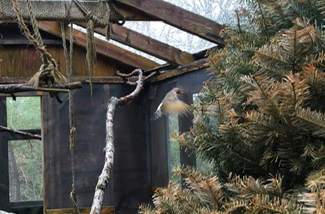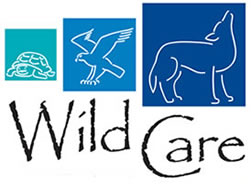
Unlucky Hawk, and Very Lucky Woodpecker
By Jennifer Taylor, Animal Care Coordinator
The doorbell rang at Wild Care, I opened the door to find a young woman. She was in a hurry to pick up her brother, but wanted me to know she had just passed two birds on Bridge Rd. One was dead and one was standing beside it. Bridge Road is very close to Wild Care. I hopped into my car to search for them. In my mind I was anticipating two songbirds, a mated pair, with one lifeless bird on the ground and the other frantically trying to revive it.
That is not what I found. Instead of my imagined scenario, the deceased bird was a Cooper’s Hawk, and a few feet away was a woodpecker – a Northern Flicker. The Flicker was probably on the roadside eating ants, his favorite food, when the hawk took that opportunity to grab him for breakfast. The hawk was run over by a car and the Flicker survived. He was puffed up and standing with his head tucked under his wing. I startled him when I gently scooped him into a pillow case. He was quick and aware.
His right eye was badly swollen and closed tight. No puncture wounds were found on his body, but head trauma was indicated by his behavior, and the presence of blood in his mouth. I made sure his tongue was centered inside his lower beak. This is something that is always checked when a woodpecker has been stunned, because a skull fracture can impede the movement of their extremely long tongues. Needless to say, all of this was very stressful for the bird. I ended my brief exam, and placed him in a small box to let him rest in a dark, quiet place.
In the morning, I was pleasantly surprised to find he made it through the night! Standing and more alert than the day before, I felt he was strong enough to further examine the injured eye. Using a warm wet compress, I managed to open the eye enough to see that the eyeball was intact and the pupil was responsive. There was no sign of puncture wounds from the hawk. This was great news! Apparently, he was only injured by blunt force, and not by sharp talons.
With a few days of supplemental nutrition, he recovered very quickly and was upgraded to a large soft pen. We offered him big, damp, bug-filled logs which he buzzed through like a chain saw. His eye was assessed by Dr. Louise Morgan and was cleared for release. After spending several days in an aviary to gain strength, we simply opened the door to release him, since he was found less than half a mile away. It is Springtime and I hope he got back to his mate!
Here he is about to land on the aviary screening. (Far right in photo.) A woodpecker’s tail feathers end in spikes to support their bodies when climbing on trees. You can see the feathers spreading out ready to do their job!

The little dot in the center of the picture at the top of the tree is the Flicker, leaving his first stop after beelining it out of our aviary.

Wild Night Out Online Auction
READY, SET, BID… We are so excited to announce that our Wild Night Out Online Auction is now live!
READ ALL NEWS
CALENDAR OF EVENTS
04 April, 2024
Wild Night Out Online Auction
EVENT DETAILS
05 April, 2024
Wild Night Out
EVENT DETAILS
28 February, 2024
Wildlife Winter/Spring Talk Series
EVENT DETAILS

DID YOU KNOW??
Wild Care has a state-of-the-art seabird therapy pool, which allows seabirds and waterfowl to exercise on running water. This will help our bird friends recover more quickly so they can get back to their watery habitats!

